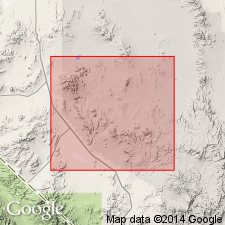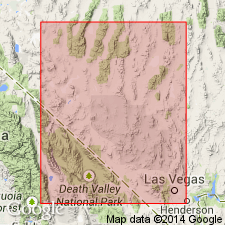
- Usage in publication:
-
- Civet Cat Canyon Member*
- Modifications:
-
- Named
- Dominant lithology:
-
- Tuff
- AAPG geologic province:
-
- Great Basin province
Summary:
Civet Cat Canyon Member, upper member of Stonewall Flat Tuff (new). Thickness about 25 m at type; maximum thickness about 300 m south of Stonewall Mountain. Original extent estimated to be at least 2,000 sq km. Overlies Spearhead Member (revised) of Stonewall Flat Tuff. Age is late Miocene. Is youngest unit in area. Report includes stratigraphic chart. Tuffs of the Stonewall Flat emanated from the Stonewall Mountain volcanic center, Nye County, Nevada. These tuffs have higher concentrations of Hf, Th, Rb, Be, and REE, than those from nearby Stonewall Mountain volcanic center.
Type locality: Pack Rat Canyon, Lat 37 deg. 32 min. 39 sec. N., Long. 116 deg. 56 min. 28 sec. W., Nye Co., NV (Great Basin province). Named from Civet Cat Canyon.
Consists of four units that cooled and crystallized together forming a single unit. The tuffs contain less than 2 percent to more than 25 percent phenocrysts, mainly sanidine-anorthoclase, lesser amounts of biotite, clinopyroxene, Fe-Ti oxides, and olivine; the latter are pseudomorphed by aggregates of iron-rich(?) phyllosilicates. Has undergone granophyric crystallization at many localities; such tuffs are red to brown due to presence of fine-grained hematite in groundmass from oxidation after loss of hydrogen gas during cooling and crystallization. Ranges from high-silica rhyolite to trachyte. Has abundant lithic fragments southeast of Stonewall Mountain.
Source: GNU records (USGS DDS-6; Denver GNULEX).

- Usage in publication:
-
- Civet Cat Canyon Member*
- Modifications:
-
- Age modified
- AAPG geologic province:
-
- Great Basin province
Summary:
K-Ar ages on sanidine phenocrysts from 4 rocks of Civet Cat Canyon Member of Stonewall Flat Tuff collected south of Stonewall Mountain (37 deg 25'11"N, 117 deg 01'15"W to 37 deg 31'42"N, 116 deg 56'30"W) gave mean age of 6.4 Ma. Ages ranged from 6.7 +/-0.2 Ma to 6.0 +/-0.2 Ma. Rocks are described as densely welded and primarily devitrified ash-flow tuff from basal vitrophyre, from central part of unit, and from upper crystal-rich caprock. Underlying Spearhead has previously been dated at average age of 6.3 +/-0.2 Ma (Noble and others, 1984). Thus two ash-flow sheets, Civet Cat Canyon and Spearhead Members of Stonewall Flat Tuff, erupted at about same time.
Source: GNU records (USGS DDS-6; Menlo GNULEX).
For more information, please contact Nancy Stamm, Geologic Names Committee Secretary.
Asterisk (*) indicates published by U.S. Geological Survey authors.
"No current usage" (†) implies that a name has been abandoned or has fallen into disuse. Former usage and, if known, replacement name given in parentheses ( ).
Slash (/) indicates name conflicts with nomenclatural guidelines (CSN, 1933; ACSN, 1961, 1970; NACSN, 1983, 2005, 2021). May be explained within brackets ([ ]).

